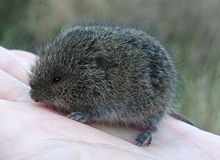The East European vole (Microtus mystacinus) is a species of vole (rodent) in the family Cricetidae.[2]
| East European vole | |
|---|---|

| |
| Scientific classification | |
| Domain: | Eukaryota |
| Kingdom: | Animalia |
| Phylum: | Chordata |
| Class: | Mammalia |
| Order: | Rodentia |
| Family: | Cricetidae |
| Subfamily: | Arvicolinae |
| Genus: | Microtus |
| Subgenus: | Microtus |
| Species: | M. mystacinus
|
| Binomial name | |
| Microtus mystacinus (de Filippi, 1865)
| |
| Synonyms | |
|
Microtus rossiaemeridionalis Ognev, 1924 | |
Distribution and habitat
editIt is found in Albania, Bulgaria, Finland, Greece, Iran, Svalbard (accidentally introduced from 1920),[3] North Macedonia, Romania, Russia, Serbia and Montenegro, Slovakia, Turkey, Ukraine and Norway.
Taxonomy
editOn Svalbard, they were first discovered in 1960 in the Grumantbyen area, and were thought to be the common vole until a genetic analysis correctly identified them in 1990.[3][4]
References
edit- ^ Zagorodnyuk, I.; Henttonen, H.; Amori, G.; Hutterer, R.; Kryštufek, B.; Yigit, N.; Mitsainas, G. & Palomo, L. (2021) [amended version of 2016 assessment]. "Microtus levis". IUCN Red List of Threatened Species. 2021: e.T13454A197293248. doi:10.2305/IUCN.UK.2021-1.RLTS.T13454A197293248.en. Retrieved 4 January 2024.
- ^ Musser, G. G.; Carleton, M. D. (2005). "Superfamily Muroidea". In Wilson, D. E.; Reeder, D. M. (eds.). Mammal Species of the World: A Taxonomic and Geographic Reference (3rd ed.). Johns Hopkins University Press. p. 1002. ISBN 978-0-8018-8221-0. OCLC 62265494.
- ^ a b "Sibling Vole (Microtus levis)". The Norwegian Polar Institute. Retrieved 4 January 2024.
- ^ Karl Fredga; Maarit Jaarola; Rolf Anker Ims; Harald Steen (December 1990). "The 'common vole' in Svalbard identified as Microtus epiroticus by chromosome analysis". Polar Research. 8 (2): 283–290. doi:10.3402/polar.v8i2.6818.
